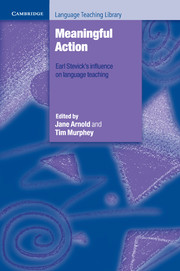Book contents
- Frontmatter
- Contents
- List of contributors
- Acknowledgements
- Preface
- Introduction
- Part A Meaning-making inside and between the people in the classroom
- Part B Meaningful classroom activity
- Part C Frameworks for meaningful language learning
- Epilogue: A way with words – perspectives on the contributions and influence of Earl W. Stevick
- Appendix: Words of tribute to Earl Stevick
- Index
Part C - Frameworks for meaningful language learning
Published online by Cambridge University Press: 15 November 2023
- Frontmatter
- Contents
- List of contributors
- Acknowledgements
- Preface
- Introduction
- Part A Meaning-making inside and between the people in the classroom
- Part B Meaningful classroom activity
- Part C Frameworks for meaningful language learning
- Epilogue: A way with words – perspectives on the contributions and influence of Earl W. Stevick
- Appendix: Words of tribute to Earl Stevick
- Index
Summary
Stevick has eloquently stressed the importance of meaning-making for language use and language learning and teaching. This also extends to issues of planning and establishing the structures and conditions which in one way or another support the language learning process by affording possibilities for engagement, belonging, challenge, agency, motivation and other facilitating factors. Hanks (1991) said that ‘structure is more the variable outcome of action than its invariant precondition’. This way of understanding structures as emerging from action correlates with much of what we know about effective ways to promote second language acquisition. For example, we take action to know our students and do activities with them that we expect may relate to their needs, and thus classroom structures emerge from our interactions to serve these needs.
Language learning and teaching entail a host of interrelated systems that as Larsen Freeman and Cameron (2008) have shown are dynamic, complex and emerging. In this part the authors look at individuals and classrooms but also bring in larger systems and networks of support for language education, as well as new ways to conceptualize language and language learning.
In Chapter 14 Heidi Byrnes argues for a reorientation in our understanding of the nature of language if our language classrooms are to prepare students for the complex demands of meaning-making that they face in an increasingly multicultural and multilingual world. Expanding Stevick's notion of ‘personal competence’, she presents lang uage and learning as quintessentially social and meaning-oriented. That means that we are always engaged with an Other, that we are borrowing words that have been used by others who gave them particular meanings, and that learning to be a competent user is learning to respect those earlier, socioculturally embedded meanings while also giving them one's own particular meanings.
In support of an ecological view of ways to structure classroom interaction, Leo van Lier stresses in Chapter 15 the importance of the classroom atmosphere and develops Stevick's idea of control and initiative on the part of both the teacher and the students, opening up possibilities for meaningful action.
- Type
- Chapter
- Information
- Meaningful ActionEarl Stevick's Influence on Language Teaching, pp. 219 - 221Publisher: Cambridge University PressPrint publication year: 2013



